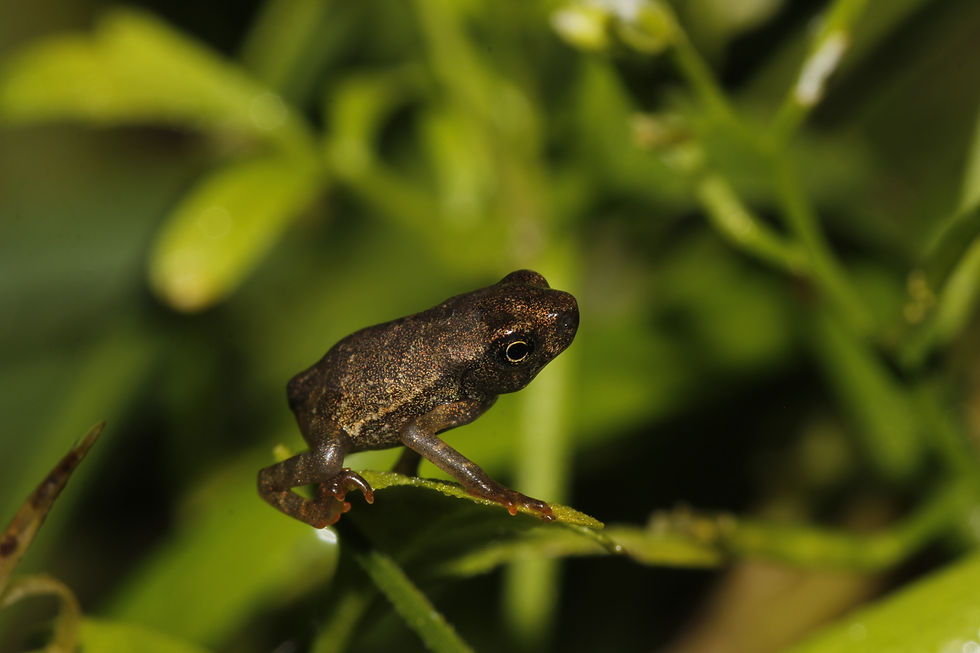The hidden jewel of the Yungas shines once again: the Three-Colored Harlequin Toad is reproducing in the wild again
- Atelopus Survival Initiative
- 2 days ago
- 3 min read
Once a common sight in the lush forests of Bolivia’s Yungas, today the Three-Colored Harlequin Toad (Atelopus tricolor), with its vibrant mix of yellow, black, and red, has become a rare and precious symbol of resilience.

Just three decades ago, scientists reported thriving populations of this species throughout its historical range, which stretched from the eastern slopes of the Peruvian Andes to the southern Yungas of Cochabamba, Bolivia. Living in pristine streams between 600 and 2,500 meters above sea level, the Three-Colored Harlequin Toad was considered a secure species, with no reason for concern among the scientific community.
But in the early 2000s, everything changed. Amphibian populations across the region collapsed, and the Three-Colored Harlequin Toad was no exception. The streams and forests that once shimmered with the presence of these colorful toads fell silent. Habitat loss, pollution, climate change, and the devastating chytrid fungus wiped out populations throughout its entire range, leading experts to fear that the species had vanished forever.
A rediscovery that changed everything
For more than 17 years, the Three-Colored Harlequin Toad seemed lost to Bolivia. Then, at the dawn of 2021, nature revealed one of its most precious treasures: two wildlife photographers exploring a small stream in the Yungas of Caranavi, La Paz, spotted four adult toads resting on the bank. One of them recognized the species immediately.
It felt like a New Year’s miracle: a handful of individuals had managed to survive, quietly adapting to the challenges of a changing environment and remaining unnoticed in the shadow of nearby human communities. This extraordinary discovery set in motion a conservation journey that has since brought together scientists, local communities, and international organizations to protect the only surviving Atelopus species in Bolivia.
From Silence to Action: A Community-Based Conservation Effort
The rediscovery of the Three-Colored Harlequin Toad stirred excitement but also deep reflection among conservationists. Sharing the news too widely could put the fragile population at risk, so the focus shifted toward discreet, well-planned scientific action. Led by the Bolivian Amphibian Initiative (BAI), a member of the Atelopus Survival Initiative (ASI), and supported by ASI, Re:wild, Milkywire, Synchronicity Earth, and the Amphibian Survival Alliance, a long-term conservation program was launched.
The first phase mapped the species’ current distribution and initiated close dialogue with local communities to foster trust and shared responsibility. The second phase identified major threats and gathered essential data on the species’ natural history, health, and behavior.
Now in progress, the third phase, titled ‘Everyone in Action: Atelopus tricolor Moves Us!’, focuses on mitigating direct threats through environmental education, sustainable livelihood alternatives, ecotourism assessments, and initiatives such as reducing agrochemical use and strengthening food security.

Hope in the Form of New Life
The greatest breakthrough came in May 2025. During a routine monitoring expedition, researchers made an exciting discovery: a juvenile toad, a clear sign of successful reproduction in the wild. This finding, together with previous records of one metamorph and two juveniles, confirms that the surviving population is reproducing naturally, offering a ray of hope for the future of the species. "This moment means everything to our team and to the local communities," says Patricia Miranda from the BAI team. "It is proof that our combined efforts are giving the Three-Colored Harlequin Toad a real chance to survive."

A Shared Commitment to Protect Bolivia’s Jewel
The ongoing conservation of the Three-Colored Harlequin Toad is not only about saving a species, but about safeguarding a piece of Bolivia’s natural and cultural heritage. Local communities, researchers, and partner organizations are working hand in hand to ensure that this jewel of the Yungas forests is not lost to future generations.
Nature has shown its resilience. Now it is our turn to protect it.




Comments